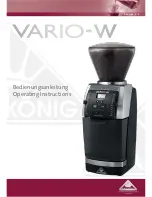
ENGLISH
31
position yourself and bystanders away from
the plane of the rotating accessory and run
the power tool at maximum no-load speed
for one minute.
Damaged accessories will
normally break apart during this test time.
h)
Wear personal protective equipment.
Depending on application, use face
shield, safety goggles or safety glasses.
As appropriate, wear dust mask, hearing
protectors, gloves and workshop apron
capable of stopping small abrasive or
workpiece fragments.
The eye protection must
be capable of stopping flying debris generated
by various operations. The dust mask or
respirator must be capable of filtrating particles
generated by your operation. Prolonged
exposure to high intensity noise may cause
hearing loss.
i)
Keep bystanders a safe distance away from
work area. Anyone entering the work area
must wear personal protective equipment.
Fragments of workpiece or of a broken
accessory may fly away and cause injury
beyond immediate area of operation.
j)
Hold power tool by insulated gripping
surfaces only, when performing an operation
where the cutting accessory may contact
hidden wiring or its own cord.
Cutting
accessory contacting a “live” wire may make
exposed metal parts of the power tool “live” and
shock the operator.
k)
Position the cord clear of the spinning
accessory.
If you lose control, the cord may be
cut or snagged and your hand or arm may be
pulled into the spinning accessory.
l)
Never lay the power tool down until the
accessory has come to a complete stop.
The
spinning accessory may grab the surface and
pull the power tool out of your control.
m)
Do not run the power tool while carrying it at
your side.
Accidental contact with the spinning
accessory could snag your clothing, pulling the
accessory into your body.
n)
Regularly clean the power tool’s air vents.
The motor’s fan will draw the dust inside
the housing and excessive accumulation of
powdered metal may cause electrical hazards.
o)
Do not operate the power tool near
flammable materials.
Sparks could ignite these
materials.
p)
Do not use accessories that require liquid
coolants.
Using water or other liquid coolants
may result in electrocution or shock.
FURTHER SAFETY INSTRUCTIONS
FOR ALL OPERATIONS
Causes and Operator Prevention
of Kickback
Kickback is a sudden reaction to a pinched or
snagged rotating wheel, backing pad, brush or
any other accessory. Pinching or snagging causes
rapid stalling of the rotating accessory which in turn
causes the uncontrolled power tool to be forced in
the direction opposite of the accessory’s rotation at
the point of the binding.
For example, if an abrasive wheel is snagged or
pinched by the workpiece, the edge of the wheel
that is entering into the pinch point can dig into the
surface of the material causing the wheel to climb
out or kick out. The wheel may either jump toward
or away from the operator, depending on direction
of the wheel’s movement at the point of pinching.
Abrasive wheels may also break under these
conditions.
Kickback is the result of tool misuse and/or incorrect
operating procedures or conditions and can be
avoided by taking proper precautions as given
below:
a)
Maintain a firm grip on the power tool and
position your body and arm to allow you to
resist kickback forces. Always use auxiliary
handle, if provided, for maximum control
over kickback or torque reaction during start
up.
The operator can control torque reaction or
kickback forces, if proper precautions are taken.
b)
Never place your hand near the rotating
accessory.
Accessory may kickback over your
hand.
c)
Do not position your body in the area where
power tool will move if kickback occurs.
Kickback will propel the tool in direction
opposite to the wheel’s movement at the point
of snagging.
d)
Use special care when working corners,
sharp edges etc. Avoid bouncing and
snagging the accessory.
Corners, sharp
edges or bouncing have a tendency to snag the
rotating accessory and cause loss of control or
kickback.
e)
Do not attach a saw chain woodcarving
blade or toothed saw blade.
Such blades
create frequent kickback and loss of control.
Содержание D28415
Страница 1: ...D28415 www eu ...
Страница 3: ...1 Figure 1 g c b a e d ...
Страница 4: ...2 Figure 2 Figure 3 Figure 5 Figure 4 n m l j k c g f i d h n l j k p o e o ...
Страница 16: ...DANSK 14 SKEMA OVER SLIBETILBEHØR forts INGEN BESKYTTELSESKÆRM Pudseskive ...
Страница 29: ...DEUTSCH 27 ÜBERSICHT ÜBER SCHLEIFZUBEHÖR Forts KEIN SCHUTZ Polierhaube ...
Страница 40: ...ENGLISH 38 GRINDING ACCESSORY CHART cont NO GUARD Polishing bonnet ...
Страница 53: ...ESPAÑOL 51 TABLA DE ACCESORIOS DE AMOLADO cont SIN PROTECTOR Bonete de pulido ...
Страница 65: ...FRANÇAIS 63 TABLEAU D ACCESSOIRES DE MEULAGE suite AUCUN CARTER Bonnet de polissage ...
Страница 78: ...ITALIANO 76 GUIDA ACCESSORI PER LA SMERIGLIATURA seguito SENZA PROTEZIONE Cuffia per lucidatura ...
Страница 91: ...NEDERLANDS 89 TABEL SLIJPACCESSOIRES vervolg GEEN BEVEILIGING Polijstkap ...
Страница 103: ...NORSK 101 OVERSIKT OVER SLIPETILBEHØR forts INGEN VERNEANORDNING Poleringshette ...
Страница 116: ...PORTUGUÊS 114 TABELA DE ACESSÓRIOS DE DESBASTE cont SEM PROTECÇÃO Acessório de polimento ...
Страница 127: ...SUOMI 125 HIOMAVARUSTEKAAVIO jatkoa EI SUOJUSTA Kiillotuslaikka ...
Страница 139: ...SVENSKA 137 DIAGRAM ÖVER SLIPTILLBEHÖR forts INGET SKYDD Polertrissa ...
Страница 151: ...TÜRKÇE 149 TAŞLAMA AKSESUAR ÇİZELGESİ devam SİPER YOK Polisaj bonesi ...
Страница 166: ...ΕΛΛΗΝΙΚΑ 164 ΔΙΑΓΡΑΜΜΑ ΠΑΡΕΛΚΟΜΕΝΩΝ ΤΡΟΧΙΣΜΑΤΟΣ Συνέχεια ΧΩΡΙΣ ΠΡΟΣΤΑΤΕΥΤΙΚΟ Κεφαλή στιλβώματος ...
Страница 167: ...165 ...
















































